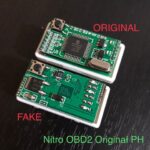Navigating the complexities of your car’s check engine light can be daunting, but understanding Obd2 Trouble Codes is the first step to effective vehicle diagnostics and repair. At OBD-Codes.com, we are your dedicated resource for all things OBD-II. Whether you’re seeking clarity on what OBD codes are, require an explanation of OBD-II codes, or need to decipher fuel trims, our comprehensive FAQ section is readily available to guide you.
OBD-II (On-Board Diagnostics II) trouble codes are standardized codes used to pinpoint potential issues within your vehicle. The most frequently encountered are P0___ powertrain codes, alongside P2___ and P3___ generic codes, all of which are crucial for diagnosing engine and transmission problems. Following closely in prevalence are P1___ powertrain codes, which are manufacturer-specific, adding a layer of detail for certain vehicle brands. Beyond powertrain issues, OBD-II codes extend to other vehicle systems. Explore B**** – Body Codes for body-related concerns, C**** – Chassis Codes for chassis and braking system issues, and U**** – Network Codes for communication network problems within your car.
Understanding Generic Powertrain OBD2 Trouble Codes
Generic powertrain trouble codes, the P0___ series, along with P2___ and P3___ codes, are standardized across all vehicle manufacturers. These Diagnostic Trouble Codes (DTCs) are designed to help identify a wide range of common vehicle problems. Below is a categorized list to help you navigate these codes. Remember, while these codes are generic and provide a starting point, they may not apply universally to every vehicle. Manufacturers may also employ vehicle-specific DTCs that slightly differ from the generic standards.
To simplify your search through the extensive list of codes, we’ve organized them into sections based on the first three characters of the code. For example, a P0171 code can be found within the P01xx section, encompassing codes from P0100 through P0199.
[Image of a person using an OBD2 scanner, focusing on the scanner and car’s interior]
“
Navigating the Code List:
If you’re unsure where to begin your code lookup, we strongly encourage utilizing our search feature. It’s the quickest way to find the specific information you need!
Important Notice: The DTC code lists provided here are for informational purposes only. Always verify the applicability of generic DTC codes to your specific vehicle before undertaking any repairs. This information is not intended as a definitive guide for vehicle repairs.
Decoding P1*** Manufacturer Specific OBD2 Trouble Codes
When your diagnostic trouble code begins with P1___, it indicates a manufacturer-specific code. These codes provide more detailed information beyond the generic OBD2 standards, often pointing to issues unique to a particular vehicle make or model. To delve deeper into P1___ codes, select your vehicle’s manufacturer from the list provided to access specific information:
[List of car manufacturers – This would ideally be a functional list linking to manufacturer-specific pages on the website, but for this exercise, a placeholder is sufficient]
Disclaimer: The information provided on OBD-Codes.com is for informational purposes only and should not be considered professional repair advice. We are not liable for any actions taken based on this information. All content on this site is protected by copyright.
